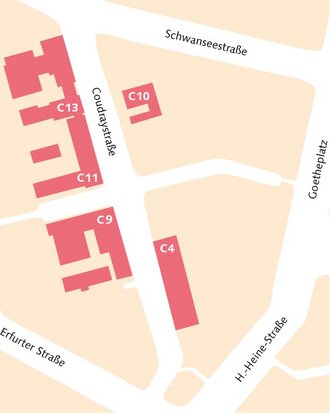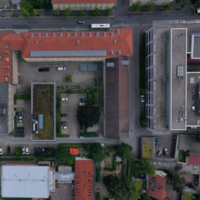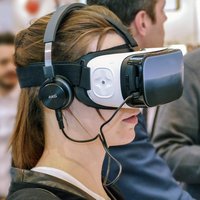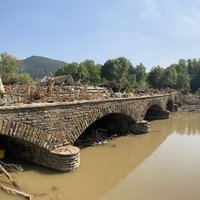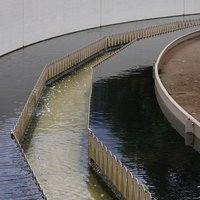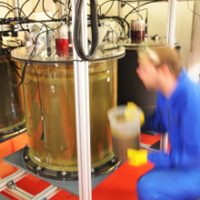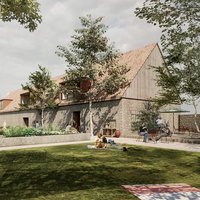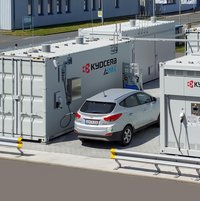Science is lived and celebrated at Coudraystraße: Take a look behind the scenes and explore the laboratories of the Faculty of Civil Engineering and the Materialforschungs- und Prüfanstalt Weimar! More than 20 exhibitors will present exciting experiments, 3D models, computer simulations and design concepts in the fields of »Building and Refurbishment«, »Energy and Environment«, »IT and Communication« and »Materials of Building«. Take the opportunity to enter into dialogue with our experts and experience current research at first hand.
Enjoy!
OPEN DAY AT COUDRAYSTRAßE
Friday, 15. July 2022
12.30 till 18.00
C4 – MFPA Weimar / Versuchstechnische Einrichtung (VTE)
C9 – MFPA Weimar / b.is Labor
C10 – b.is Technikum
C11 – F.A. Finger-Institut für Baustoffkunde
C13 – Wasserstofflabor / Schlierenlabor
From the hidden university to a Science Mile
In the summer semester, students developed a concept for how the Coudraystraße campus could be redesigned in the future to make the location more attractive for members of the university as well as for the public.
Location: Ground floor, corridor | Poster exhibition
Resilient and ecological
Due to its good load-bearing and insulating properties, straw is suitable as a green alternative to conventional building materials. Current student theses and an experiment on load-bearing straw bale construction will be presented.
VTE, ground floor (hall) | demonstrations 13.00/15.00/17.00
Immersive Virtual Reality Experiments
The aim of the project is to build a European, cross-university VR learning platform in civil engineering. Experience the first virtual tours and various e-learning scenarios.
VTE, ground floor (hall) | interactive exhibition 15.00-18.00
Theses of the NHRE study programme
In the Master's programme »Natural Hazards and Risks in Structural Engineering«, challenging engineering tasks are solved in the planning, construction and realisation of structures under the influence of earthquakes, wind and floods, among others.
VTE, ground floor | poster exhibtion

ADDITIVE MANUFACTURE
3D Printing at MFPA
The ExAM 255 is the world's first industrial 3D printer that processes injection moulded granulate. It will be demonstrated how precisely fitting technical ceramic components are printed from granulate, which can be used almost everywhere.
MFPA Weimar, ground floor (hall) | duration: 15-20 Min.
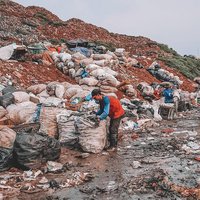
LESS IS MORE
Sealing a landfill
To prevent emissions from escaping into water or air, it makes sense to seal a landfill. It will be explained which sealing and drainage systems are most suitable.
MFPA Weimar, ground floor (hall) | duration: 20 Min.
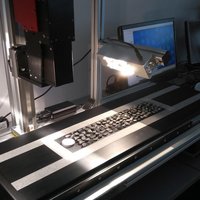
MAKING THE INVISIBLE VISIBLE
Hyperspectral image analysis
The human eye sees the environment multispectrally in the wavelengths of the primary colours red, green and blue. Using various materials, it will be demonstrated how hyperspectral image analysis is used to classify materials.
MFPA Weimar, ground floor (hall, room L.06) | duration: 5- 10 Min.
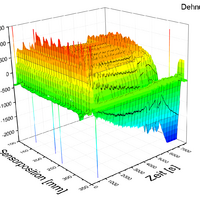
3D-PRINTING
... meets fibre optic sensor technology
Fibre optic sensors (FOS) use optical waveguides to investigate a variety of measurands. The possibilities opened up by the analysis method in combination with 3D printing of plastics will be illustrated.
MFPA Weimar, 2nd floor (module 3, room 27) | duration: 20-25 Min.

EXPERIMENTAL STRUCTURAL DYNAMICS
Student project
The application of methods to identify the natural vibration behaviour of structures is demonstrated on two complex model structures.
VTE, ground floor | poster exhibtion

DENKRAUM
Evaluation and Preservation of Room Truss Structures
The DFG project examines the room truss systems created in Germany within the 1920s to 1970s with regard to their monument value and structural condition.
VTE, ground floor | poster exhibtion

VIRTUAL MECHANICS-LABORATORY
With the help of the software "Unity3D", a virtual learning space was created for students, which conveys knowledge from mechanics and encourages virtual experimentation. Try it out!
VTE, ground floor | interactive exhibition
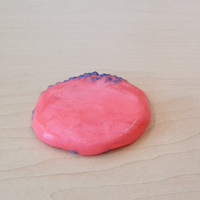
BOUNCING DOUGH OR HARD STONE
How shear forces can influence viscosity
Simple examples are used to explain the phenomenon of time-dependent material deformation and how this material property is measured with modern methods.
MFPA Weimar, ground floor (room B004) | duration: 15 -25 Min.

5 ELEPHANTES / 25 TONNES
How long does the material last?
Universal testing machines are used to demonstrate how materials such as mortar and steel deform under load. This is important to increase the safety of load-bearing structures and to avoid structural damage.
MFPA Weimar, ground floor (room B003) | duration: 30 Min.
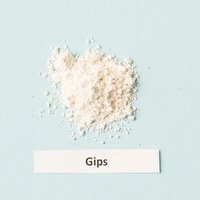
TRY OUT GYPSUM RECYCLING
What gypsum has to do with the coal phase-out
Gypsum waste is generated during the processing of plasterboard as well as during the renovation and deconstruction of buildings. Create small plaster figures to take home and learn playfully how the material can be recycled.
MFPA Weimar, ground floor (lobby)

ON TRACK OF THE ELEMENTS
X-ray fluorescence analysis
Wavelength dispersive X-ray fluorescence analysis (WDXRF) is an analytical method for obtaining data on the elemental composition of various materials such as cement or glass. From the sample to the analysis result - Learn more about the application and fields of application of this method.
MFPA Weimar, ground floor (room A001)
What does wastewater reveal about us? And how can it be used to combat infectious diseases such as the coronavirus? Visit our laboratory and get an insight into current research results from wastewater monitoring in Thuringia.
b.is-Labor (access via the scaffolding, between C7 and MFPA) | demonstrations 13.00/15.00/17.00
Waste and wastewater cycle explained
What is the difference between grey and black water and how can valuable resources contained in our waste and wastewater be (re)utilised?
b.is Technikum, 2nd floor (access via side entrance) | demonstrations every hour on the hour
In the past winter semester, eleven architecture students dealt with the upgrading, conversion and renovation of the historically significant Ackerbürgerscheunen.
FIB, 1st floor (corridor) | Exhibition
Guided tour of the FIB laboratories
For more than 60 years, building materials have been researched and developed at the F.A. Finger-Institut für Baustoffkunde in order to meet the manifold demands of new construction, renovation, environmental protection, recycling and the use of residual materials.
FIB (C11a), ground floor (lobby, meeting point: laboratory tour) | demonstrations every hour on the hour.
Self-made boats from concrete
Since 1986, students of Weimar have been proving that self-made boats of concrete can float. Examine the latest models and learn more about the process of creating the canoes.
C11A, ground floor (lobby) | Interactive exhibition and boats
For a successful energy and mobility transition
In the hydrogen laboratory of the Chair of Energy Systems, you will gain insight into how an electrolyser works and learn how green hydrogen is produced, processed and stored.
hydrogen lab (C13c), ground floor, room 015 | 15.00 till 17.00
Applied research in the Schlieren laboratory
Discover the worldwide unique Schlieren Laboratory of the Chair of Building Physics and learn how hidden indoor air currents become visible.
Schlierenlabor (C13b), 1st floor, room 110 | 15.00 till 17.00

